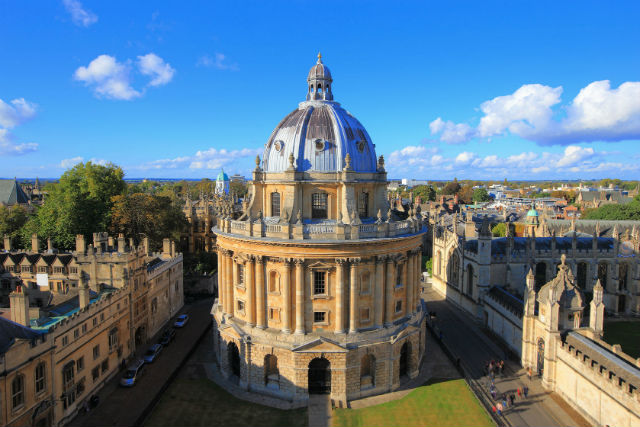This post is part of a series where I share some of my world travels, which my love for organs has taken me. I help friends, associates and fellow organ lovers with projects that mean I get to see new and old organs in gorgeous settings and really experiment with this instrument.
Those of you who have read my earlier blogs in this series will recall that they all have been for CD recordings. On this occasion I was turning and registering for a live concert which is altogether a more pressured challenge, especially at the Oxford Town Hall organ where one needs the additional skill of a tightrope walker.
The Willis Organ
The Willis built in 1897 has 4 manuals but just a single thumb piston which after about 3 seconds of holding in pneumatically brings out Great to Pedal. So it is of no practical use at all! The organist can get at 8 combination pedal levers (4 Swell and 4 Great) that are of some help but as the swell shutter ‘lever’ is so awkward, requiring a toe to be got under it to move it up to close the box, it takes full concentration to do that. As pulling up with the right foot is not a comfortable movement whilst trying to push down with the left the use of these levers is fraught with challenge. This a really good example of an instrument that could benefit from the addition of modern playing aids. Yes of course it would ‘change the experience’ but it would make life at the console for the unassisted organist a joy, and the page turner would not mind either!
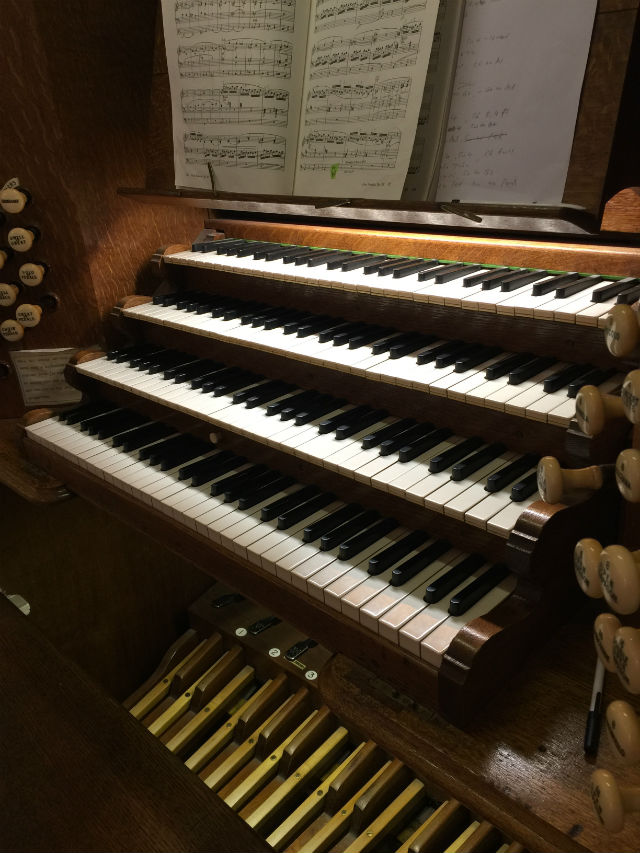 And so at this organ much of the registration is left to the page turner, but here is the additional difficulty. The organ bench is just 6 inches away from the terrace edge with a drop of about 2 ft down to the next level so moving from side to side requires a crab like gate to ensure you do not fall backwards into thin air. It must be a strange sight to the audience as the assistant shuffles from left to right, sometimes at speed, trying to adjust the stops and turn the pages as well. Happily it went quite well and only on one occasion did some loose papers fly off the music desk as all this pantomime was in progress.
And so at this organ much of the registration is left to the page turner, but here is the additional difficulty. The organ bench is just 6 inches away from the terrace edge with a drop of about 2 ft down to the next level so moving from side to side requires a crab like gate to ensure you do not fall backwards into thin air. It must be a strange sight to the audience as the assistant shuffles from left to right, sometimes at speed, trying to adjust the stops and turn the pages as well. Happily it went quite well and only on one occasion did some loose papers fly off the music desk as all this pantomime was in progress.
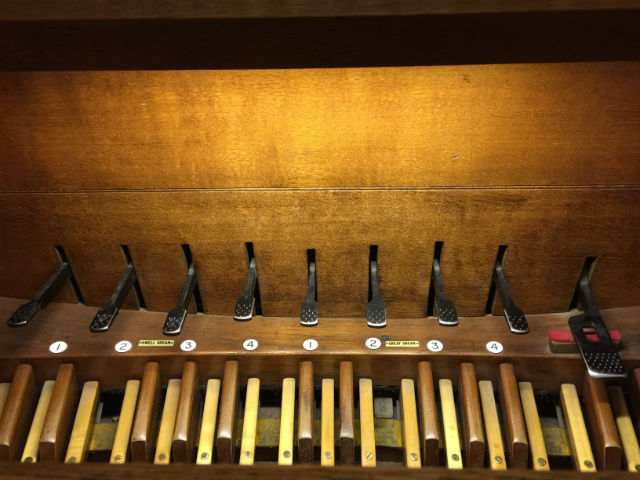
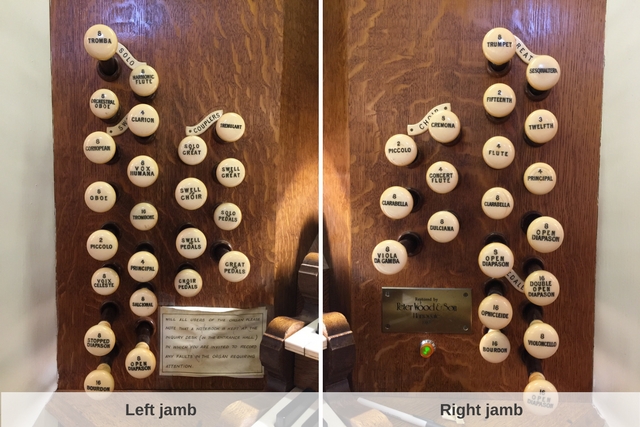 Concert Time
Concert Time
I was there to help Francis Rumsey get through the lunchtime concert which is part of a monthly series the town hall put on. I was there many years ago to page turn and today there still remains a rather quaint flavour to these concerts. The seating is set up against a series of trestle tables (picture below) where the audience is expected, as many indeed do, to eat their picnic lunches. A great urn of coffee sits on a trolley at the rear of the ballroom where a selection of biscuits is also provided all of which is included in the £5 entrance fee. Were it not for the refreshments one might think the room was set up as an overflow for the examination schools and any minute a cohort of gowned students would appear to sit a demanding test paper.
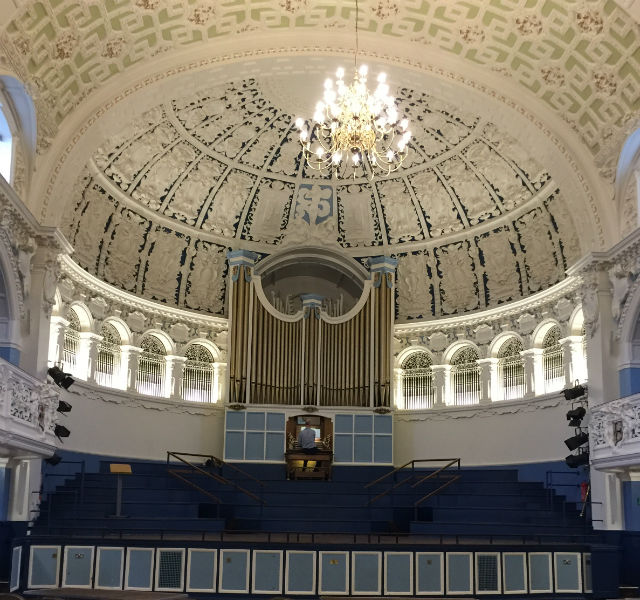 I imagine these concerts have gone on in this same way for many decades, genteel respectful quiet attendance broken only by the occasional clink of a spoon stirring the coffee or a knife cutting a home made sandwich with a 5 minute interval at half time to refresh the coffee cups. So typically Oxford!
I imagine these concerts have gone on in this same way for many decades, genteel respectful quiet attendance broken only by the occasional clink of a spoon stirring the coffee or a knife cutting a home made sandwich with a 5 minute interval at half time to refresh the coffee cups. So typically Oxford!
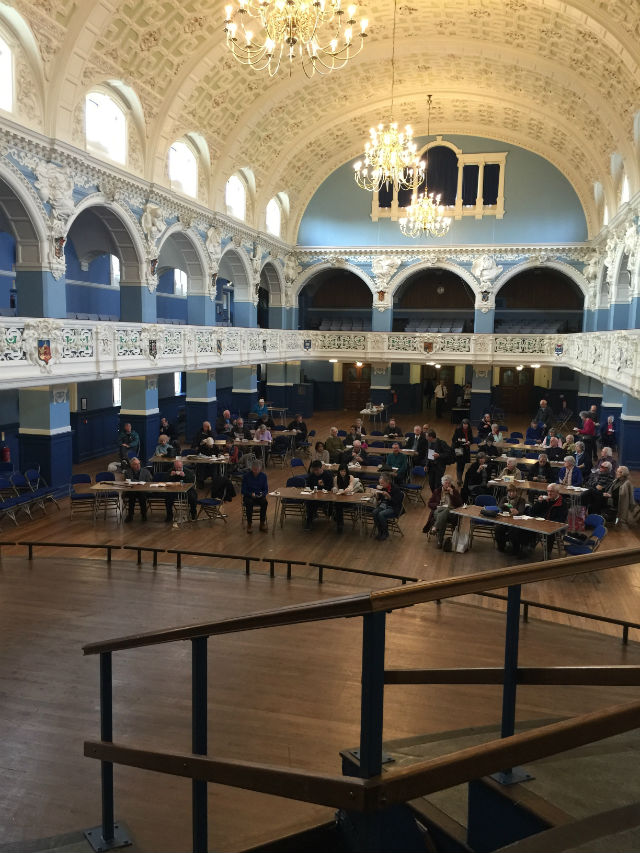 The Programme
The Programme
The programmes for these events err on the lighter side of the repertoire and Francis’s selection fitted this and the magnificent organ well. This is a delightful Willis with magnificent fiery reeds that were his signature and a Tuba (although the stop head says Tromba) on the Solo that would part your hair.
Francis started with a charming Handel Organ Concerto, No 2 in B flat, a light hearted dancing piece exploiting the contrast of flutes and principals available on all 3 main manuals. No registration work there for the page turner, so a nice gentle warm up for both musician and assistant.
Next an arrangement of the Tchaikovsky Polonaise from Eugene Onegin got feet tapping and introduced the audience of about 50 or so to the Willis reeds and brought my crab like side shuffle into play.
Next I was introduced to a new piece, the Introduction and Passacaglia by Alcock. By a strange twist of fate his great grand daughter lives in Witney and she was present in the audience.
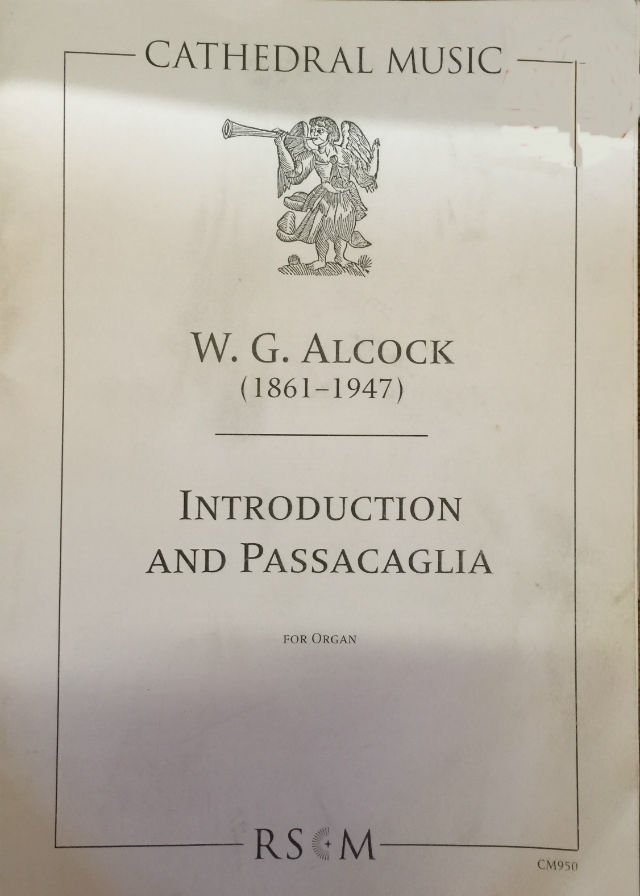 A short interval followed and the concert continued with the Mozart Fantasia in F minor, in places horribly difficult as it was written for a mechanical clock that clearly had at least 3 hands as at times 15 fingers are needed to play all the notes. The conclusion was one of my favourites the finale from Guilmant’s first organ sonata which is a real corker of a piece. Guilmant’s organ output is immense and happily much of it is not too difficult. I use it a lot pre and post services as it even works well on the rather poor single manual instruments in the churches where I play on Sundays, when I can’t think of an excuse to pass the joy of trying to get a good tune out of the rather old and badly maintained village pipe organs at my disposal. But that is another story that I can bore you on at length in a future blog.
A short interval followed and the concert continued with the Mozart Fantasia in F minor, in places horribly difficult as it was written for a mechanical clock that clearly had at least 3 hands as at times 15 fingers are needed to play all the notes. The conclusion was one of my favourites the finale from Guilmant’s first organ sonata which is a real corker of a piece. Guilmant’s organ output is immense and happily much of it is not too difficult. I use it a lot pre and post services as it even works well on the rather poor single manual instruments in the churches where I play on Sundays, when I can’t think of an excuse to pass the joy of trying to get a good tune out of the rather old and badly maintained village pipe organs at my disposal. But that is another story that I can bore you on at length in a future blog.
By the way you may have seen Francis delivering our You Tube films that explain all the features on the Viscount Physis organs. If you have not yet had a look you can find them here.
Francis is a man of precision and the concert concluded at about 2 minutes to one o’clock. Perfect timing and so off to the White Horse on the Broad for a well earned pie and a pint!
I have had a passion for church organs since the tender age of 12. I own and run Viscount Organs with a close attention to the detail that musicians appreciate; and a clear understanding of the benefits of digital technology and keeping to the traditional and emotional elements of organ playing.
